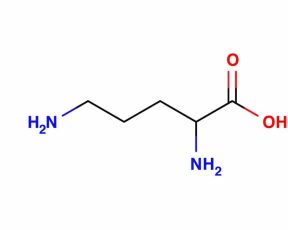BEVITAL AS
Targeted Metabolomics Services
Ornithine

Menu
Updated 21/12/2022
What is ornithine?
Ornithine is a non-proteinogenic alpha-amino acid. Within the cell, ornithine is located in the mitochondria and the cytoplasma, and is a central component of the urea cycle, that is involved in the disposal of excess nitrogen (2; Fig. 1).
Ornithine is involved in numerous metabolic processes, including the formation of citrulline, proline and polyamines, and many inborn errors and metabolic diseases (2,3). Health benefits, including enhanced athletic performance and wound healing, have been attributed to increased ornithine intake as supplement, and concentrations in blood and tissues have been linked to chronic diseases such as Alzheimers disease, liver disease and cancer (4).
Method: GC-MS/MS.
Indication(s)
Should be measured together with arginine and citruline.
Specimen, collection and processing
Matrix: EDTA plasma and serum.
Volume: Minimum volume is 50 µL, but 200 µL is optimal and allows reanalysis.
Preparation and stability: The blood sample must be centrifuged and the plasma/serum fraction put on ice, and frozen.
Transportation
Frozen, on dry ice. (for general instruction on transportation, click here)
Reported values, interpretation
Reported values: 30-90 µmol/L
Intraclass correlation coefficient (ICC): NA.
Literature
1. Midttun, Ø., McCann, A., Aarseth, O., Krokeide, M., Kvalheim, G., Meyer, K., and Ueland, P.M. (2016). Combined measurement of 6 fat-soluble vitamins and 26 water-soluble functional vitamin markers and amino acids in 50 μL of serum or plasma by high-throughput mass spectrometry. Anal Chem 88, 10427-436.
2. Barmore, W., Azad, F., & Stone, W. L. (2020). Physiology, Urea Cycle. In StatPearls. StatPearls Publishing.
3. Stone, W. L., Basit, H., & Jaishankar, G. B. (2021). Urea Cycle Disorders. In StatPearls. StatPearls Publishing.
4. Caldwell, R. W., Rodriguez, P. C., Toque, H. A., Narayanan, S. P., & Caldwell, R. B. (2018). Arginase: A Multifaceted Enzyme Important in Health and Disease. Physiol Rev, 98, 641-665.

